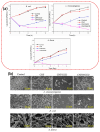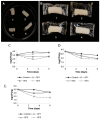The Role of Active Packaging in the Defense Against Foodborne Pathogens with Particular Attention to Bacteriophages
- PMID: 40005767
- PMCID: PMC11858251
- DOI: 10.3390/microorganisms13020401
The Role of Active Packaging in the Defense Against Foodborne Pathogens with Particular Attention to Bacteriophages
Abstract
The increasing demand for food safety and the need to combat emerging foodborne pathogens have driven the development of innovative packaging solutions. Active packaging, particularly those incorporating antimicrobial agents, has emerged as a promising approach to enhance food preservation and safety. Among these agents, bacteriophages (phages) have gained significant attention due to their specificity, efficacy, and natural origin. This manuscript explores the role of active packaging in protecting against foodborne pathogens, with a particular focus on bacteriophages. The review overviews recent advances in antimicrobials in food packaging, followed by a detailed discussion of bacteriophages, including their classification, mode of action, multidisciplinary applications, and their use as antimicrobial agents in active food packaging. The manuscript also highlights commercially available bacteriophage-based products and addresses the challenges and limitations associated with their integration into packaging materials. Despite their potential, issues such as stability, regulatory hurdles, and consumer acceptance remain critical considerations. In conclusion, bacteriophages represent a promising tool in active packaging for enhancing food safety, but further research and innovation are needed to overcome existing barriers and fully realize their potential in the food industry.
Keywords: active food packaging; antimicrobials; food safety; phage therapy.
Conflict of interest statement
The authors declare no conflicts of interest.
Figures






Similar articles
-
Bacteriophages: Natural antimicrobial bioadditives for food preservation in active packaging.Int J Biol Macromol. 2024 Sep;276(Pt 2):133945. doi: 10.1016/j.ijbiomac.2024.133945. Epub 2024 Jul 18. Int J Biol Macromol. 2024. PMID: 39029821 Review.
-
A Review on Recent Trends in Bacteriophages for Post-Harvest Food Decontamination.Microorganisms. 2025 Feb 27;13(3):515. doi: 10.3390/microorganisms13030515. Microorganisms. 2025. PMID: 40142412 Free PMC article. Review.
-
Bacteriophages: a potential game changer in food processing industry.Crit Rev Biotechnol. 2024 Nov;44(7):1325-1349. doi: 10.1080/07388551.2023.2299768. Epub 2024 Jan 16. Crit Rev Biotechnol. 2024. PMID: 38228500 Review.
-
Advanced strategies to overcome the challenges of bacteriophage-based antimicrobial treatments in food and agricultural systems.Crit Rev Food Sci Nutr. 2024;64(33):12574-12598. doi: 10.1080/10408398.2023.2254837. Epub 2023 Sep 12. Crit Rev Food Sci Nutr. 2024. PMID: 37698066 Review.
-
Recent knowledge in phages, phage-encoded endolysin, and phage encapsulation against foodborne pathogens.Crit Rev Food Sci Nutr. 2024 Nov;64(32):12040-12060. doi: 10.1080/10408398.2023.2246554. Epub 2023 Aug 17. Crit Rev Food Sci Nutr. 2024. PMID: 37589483 Review.
Cited by
-
Regulatory Landscape and the Potential of Bacteriophage Applications in the United States' Food Industry.J Food Prot. 2025 May 22;88(6):100510. doi: 10.1016/j.jfp.2025.100510. Epub 2025 Apr 21. J Food Prot. 2025. PMID: 40268121 Free PMC article. Review.
References
-
- Onyeaka H., Ghosh S., Obileke K., Miri T., Odeyemi O.A., Nwaiwu O., Tamasiga P. Preventing Chemical Contaminants in Food: Challenges and Prospects for Safe and Sustainable Food Production. Food Control. 2024;155:110040. doi: 10.1016/j.foodcont.2023.110040. - DOI
-
- Kirk M.D., Pires S.M., Black R.E., Caipo M., Crump J.A., Devleesschauwer B., Döpfer D., Fazil A., Fischer-Walker C.L., Hald T., et al. World Health Organization Estimates of the Global and Regional Disease Burden of 22 Foodborne Bacterial, Protozoal, and Viral Diseases, 2010: A Data Synthesis. PLoS Med. 2015;12:e1001921. doi: 10.1371/journal.pmed.1001921. - DOI - PMC - PubMed
Publication types
Grants and funding
LinkOut - more resources
Full Text Sources

